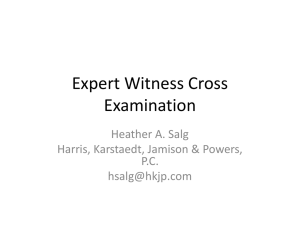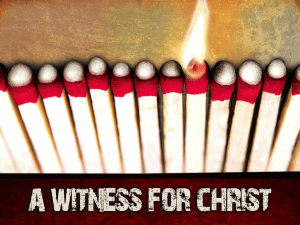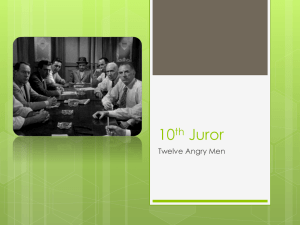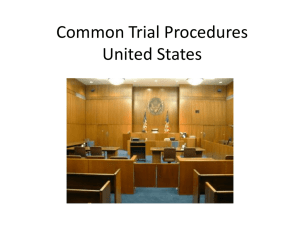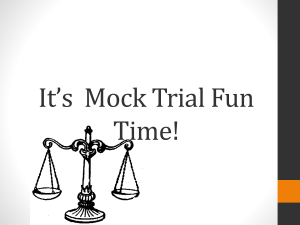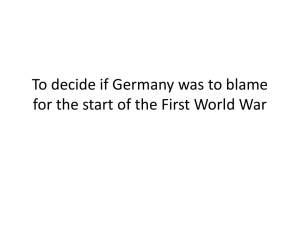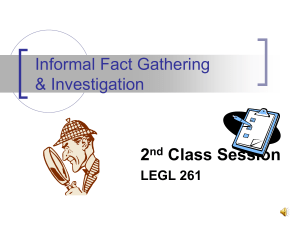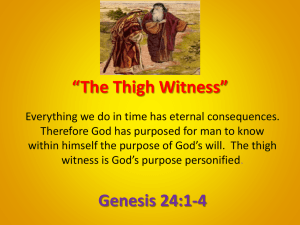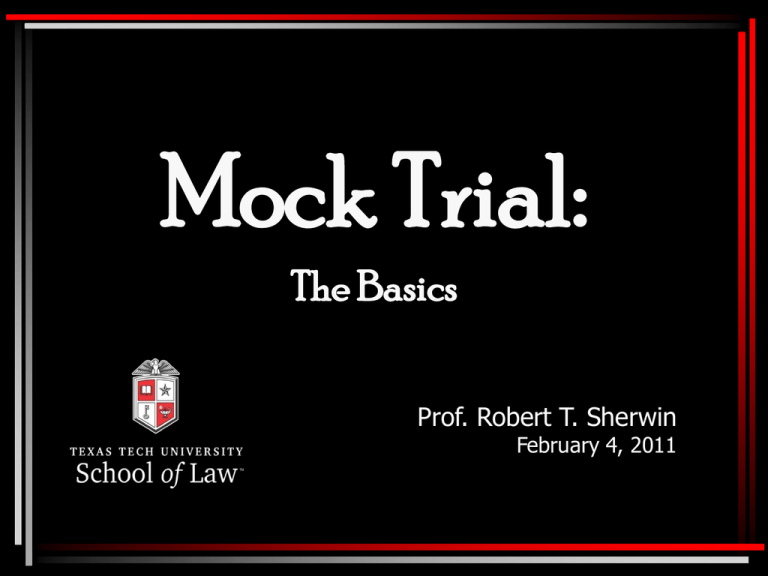
Mock Trial:
The Basics
Prof. Robert T. Sherwin
February 4, 2011
Mock Trial: Defined
• Mock: Feigned; not real; sham.
• Trial: The examination before a judicial
tribunal of the facts put in issue in a
cause, often including issues of law as
well as those of fact.
• In short: A simulated trial!
• It is NOT a simulated oral argument
(that’s moot court).
2
How we prove and determine facts
• In the American justice system, juries
(or judges) are asked to determine
facts based upon evidence.
• Evidence generally comes in two forms:
– Witness testimony
– Physical evidence (documents, videos,
objects)
3
Witness testimony
• Witnesses are “called to the stand” to give
testimony under oath.
• Their testimony comes in the form of
answers to questions (an “examination”)
by the attorneys.
• The party who calls the witness to testify
conducts the “direct examination” of the
witness.
• The side against whom the witness
testifies conducts the “cross examination.”
4
Physical evidence
• Witnesses may be asked to testify
about documents, videos, or other
physical objects.
• These pieces of physical evidence can
be “admitted into evidence” as
“exhibits” and be considered by the jury
to the same extent it considers witness
testimony.
5
Trial – in sum
• The purpose of the trial is to allow each
side to introduce evidence that the fact
finder can use to answer questions of
fact.
6
How does a mock trial go?
• Housekeeping/motions in limine
• Opening statements
• Plaintiff/Prosecution puts on evidence
(two witnesses)
• Defendant moves for directed
verdict/acquittal
• Defendant puts on evidence (two
witnesses)
• Closing arguments
7
Division of duties
• You compete as a team of two.
• One teammate delivers the opening
statement; the other delivers the
closing argument.
• Each teammate conducts a direct
examination of one of your witnesses
and a cross examination of one of the
other team’s witnesses.
8
Division of duties (cont.)
• Other matters (housekeeping,
dispositive motions) may be divided as
you see fit, but try to equal each
teammate’s “face time” as much as
possible.
• You must prepare both sides (Plaintiff
AND Defendant) of the case; you will
switch throughout the competition.
9
Formalities
• Plaintiff/Prosecution sits at table closest
to jury box (or left if no jury box).
• Stand up when the judge enters or calls
the court to order (and any time you
speak).
• Judge will ask attorneys to make their
announcements (Plaintiff/Prosecution
goes first).
10
Housekeeping
• Opportunity to address preferences of
the judge in how trial will proceed.
– Permission to roam about courtroom
during opening/closing?
– Arm’s length from podium during witness
questioning?
– Constructive approach/witness swearing?
– Reading of jury instructions?
– Addressing judge as both judge and jury?
• Plaintiff should present motions first.
11
Opening statement
• Your opportunity to introduce yourself
and present your theory of the case.
• Tell the jury what you expect the
evidence will show.
• This is an opening “statement,” not an
opening “argument” – you are not
supposed to be argumentative or
combative.
• Opening statements are NOT evidence!
12
Opening statement (cont.)
• Should last no more than five minutes
• “May it please the Court? Counsel
[acknowledge opposing counsel].
Ladies and gentlemen of the jury [turn
to the jury].”
• Introduce yourself, your co-counsel,
and the party you represent.
• Begin telling your client’s story as
framed by your “theme.”
13
Theme
• You should always have a theme to
describe your case – a “hook” the jury
can latch on to and conceptualize the
evidence through.
• Examples:
– “If the glove don’t fit…”
– CSI
– Desperate Executives
14
Opening statement (cont.)
• Explain the dilemma in the case – what
the plaintiff is claiming or why the
plaintiff is wrong.
• Explain the burden of proof and the
elements of the claim (particularly if
you’re the plaintiff).
• Introduce your witnesses and explain
how you expect them to testify.
• Explain how you expect the other side’s
witnesses to testify.
15
Opening statement tips (cont.)
• Couch everything in terms of “we
expect the evidence will show” or “the
evidence will likely show” or “you’ll
learn that…”
– Remember – you haven’t held the trial yet,
so you can’t say things as a matter of fact
that are in dispute!
• Objections?
• Ending: Ask the jury to carefully weigh
the evidence and find for your client.
16
Direct examination
• After each side has opened, the parties
put on their “case in chief.” You do this
through calling witnesses.
• Decide which of your two witnesses you
want to call first.
• When the judge asks you to call your
first (or next) witness, stand and say
“Your Honor, the Plaintiff calls Witness
McWitnessy to the stand.”
17
Direct examination (cont.)
• Make sure witnesses have carefully read
their deposition/statements. Give them
a list of the questions you’re going to
ask and the answers you’d like them to
give (even though they can’t take that
to the stand with them).
• Plan out your questions according to
subject areas. Within each subject
area, move chronologically so your
questions make sense.
18
Direct examination (cont.)
• What do you need from the witness?
• Be sure to ask whatever questions
necessary to get the witness to testify
about the essential elements of your
claim. If the witness doesn’t say it, it’s
not in evidence and you haven’t proven
your case!
• Ask open-ended questions. Any
question that suggests its answer is
leading, and therefore objectionable.
19
Direct examination (cont.)
• Use the witness to explain physical
evidence.
• To give the witness an exhibit, first ask
the judge, “Your Honor, may I approach
the witness?”
• Before you approach the witness, give a
copy of the exhibit to opposing counsel,
and ask the judge if he/she would like a
copy as well.
20
Direct examination (cont.)
• Once you finish your direct
examination, look to the judge and say
“Your honor, I pass the witness.”
• Don’t say “I have no further questions,”
which may lead a mean judge to say
that you’ve waived your right to do a
re-direct examination after cross.
21
Cross examination
• Your opportunity to “question” the
other side’s witnesses
• Goals:
– Tell “the rest of the story”
– “Impeach” a witness/make him look bad
– Collect ammo for closing argument
– Make yourself look good
• Hardest part about trial work (and mock
trial). Also most fun.
22
Why so hard?
• Three reasons:
– Witness is adverse
– What we think we know about cross is
wrong
– Can’t rehearse it
• Control over the witness is vital.
Without it, the examination goes badly.
• With control, you look good, and when
the witness tries to deny you of it, he
looks bad.
23
How to get control?
• Leading questions?
• No! SHORT, SIMPLE, STATEMENTS
24
Problems with questions
• Jury wants to hear the witness’s
answers.
• You lose the ability to tell a story.
25
The benefit of short statements
• The length of the statement dictates
the length of the response.
• Focusing on short statements prevents
asking compound questions that allow
the witness to say “No” when at least
part of the answer begs a “Yes.”
• Allows you to communicate with the
jury, not the witness.
26
So how do I do it?
• Decide the points you need to make through
the examination.
• Only ask questions to transition from point to
point.
– Mr. Smith, I’d like to ask you some
questions about _____. Is that OK?
• Eliminate prefixes.
• Eliminate suffixes.
• Design short statements to move in a logical
progression toward each point you need to
make.
27
What if it doesn’t work?
• If witness stares at you, say, “Correct”
or “Isn’t that right?” while nodding. On
the next statement, nod.
• If witness argues with you or says
something other than “Yes,” listen to
his answer. And then…
28
What NOT to do
• The “Deal”
• Cut off witness and thank him/her for
answer
• “Just answer yes or no”
• Ask the court for help (except as a last
resort)
29
What TO do
• Ask, repeat, repeat.
– Or ask, repeat, reverse.
• Full, formal name.
• Shorten the question.
• “I’m sorry, you must have misunderstood my
question. I wasn’t asking about…”
• “That didn’t answer my question, did it?”
• “Then your answer is yes?”
30
Cross examination tips
• There’s no need to be mean to the
witness
• Avoid the “one question too many” – it
might be OK to save the conclusion for
jury argument.
• Try to end with a powerful point.
• “Pass the witness” when you’re done.
31
Re-direct examination
• The person who calls the witness
always has “the last word.” So, after
cross, you can ask additional direct
examination questions of your witness.
• Fix any damaging testimony that came
out on cross by letting the witness
explain.
• Limited to scope of direct/cross.
32
Re-direct examination
• When you’re done, say “Your Honor, I
have no further questions. May this
witness be excused?”
• No re-cross examination allowed in our
mock trial competitions.
33
Closing the “case in chief”
• After the Plaintiff has called its two
witnesses, rise and tell the judge “Your
Honor, at this time the Plaintiff rests its
case in chief.”
• Defendant should do the same after it
calls its two witnesses in its case in
chief.
34
Motion for Directed Verdict (Halftime!)
• After the Plaintiff rests its case in chief,
the Defendant should ask the judge to
excuse the jury.
• Defendant then moves for a Directed
Verdict, arguing that the Plaintiff did
not put on sufficient evidence to prove
a prima facie case.
• Argue the elements of the cause(s) of
action and why they weren’t met.
• It will be denied. That’s OK!
35
Closing argument
• Opportunity to be theatrical (and
argumentative!).
• Use the same theme that your partner
introduced in opening.
• Talk about what the witnesses said. If
a witness didn’t say it or it didn’t appear
in an admitted exhibit, you can’t talk
about it!
• Point out inconsistencies in opposing
witness’s statements.
36
Closing argument (cont.)
• Explain the elements of the claim and
how the evidence did/did not establish
those elements.
• If there are jury instructions, explain
them and how the jury should answer.
• Explain the burden of proof and make it
work for you.
• Ask the jury to hold for your client.
• Plaintiff can reserve time for rebuttal.
37
Objections
• For 1L mock trial, we’ve eliminated
nearly all evidentiary objections.
• The objections you may make:
– Ambiguous
– Argumentative
– Asked and answered
– Assumes facts not in evidence
– Compound
– Leading
– Narrative
38
Objections (cont.)
• The objections you may make (cont.):
– Non-responsive (as to witness testimony)
– Relevance
• You may not object to any evidentiary
issues other than relevance. In
particular, no hearsay objections!
• Only the attorney handling that witness
may object.
• Keep a list of available objections at
counsel table.
39
Objections (cont.)
• When the other side asks a question
that is objectionable, rise and say
“Objection, Your Honor,” and then state
the grounds of your objection.
• The counsel objected to should then
say, “May I respond your Honor?”
(unless you know you’re wrong, in
which case just say, “I’d be happy to
rephrase, your Honor.”)
40
Closing thoughts
• Keep counsel table neat and clean.
Consider putting everything in a binder
with tabs.
• Other than announcements and
objections, speak from podium (unless
permission to roam in opening/closing).
• Stand up straight – look like a lawyer!
• Don’t talk or overly whisper to cocounsel.
41
Mock Trial:
The Basics
Prof. Robert T. Sherwin
February 4, 2011

